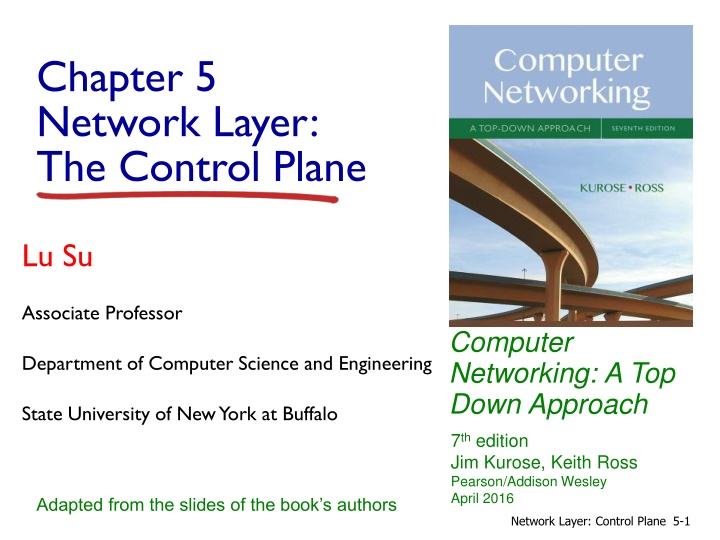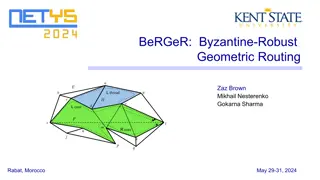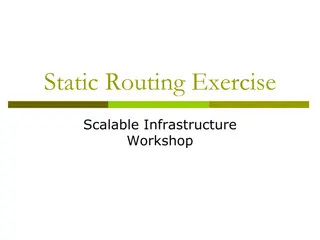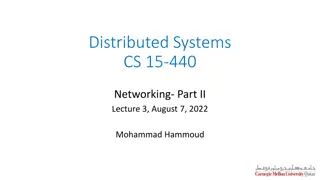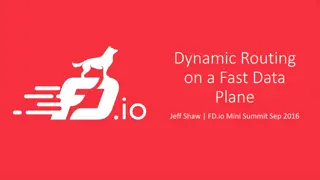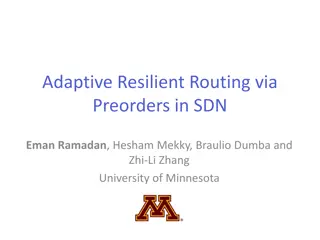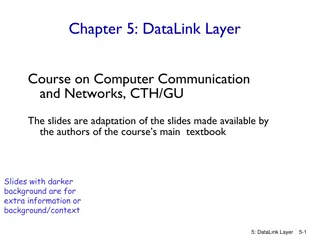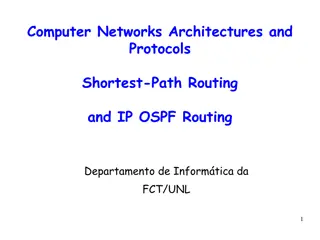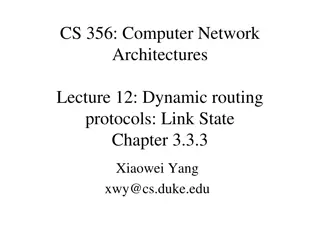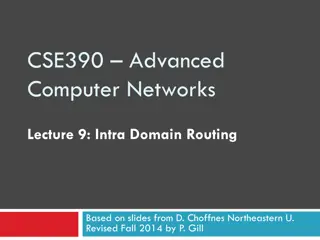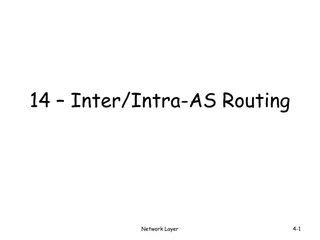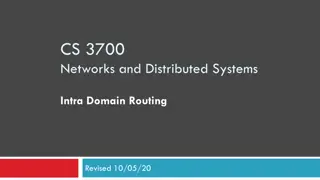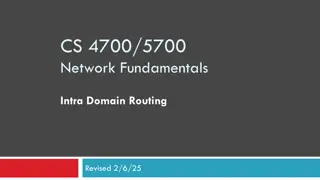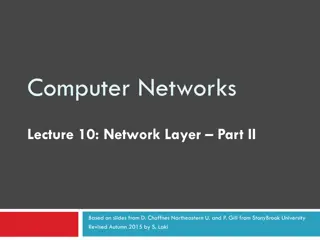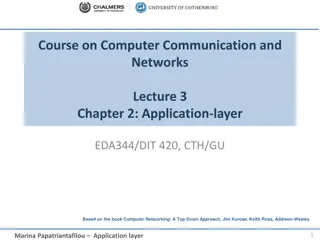Network Layer Control Plane: Routing Protocols Overview
In this chapter, the focus is on the network control plane, particularly exploring traditional routing algorithms, SDN controllers, important protocols like OSPF, BGP, ICMP, SNMP, and their implementation in the Internet. Learn about the fundamentals of network control plane and the role it plays in determining packet routing in various network scenarios.
Download Presentation

Please find below an Image/Link to download the presentation.
The content on the website is provided AS IS for your information and personal use only. It may not be sold, licensed, or shared on other websites without obtaining consent from the author.If you encounter any issues during the download, it is possible that the publisher has removed the file from their server.
You are allowed to download the files provided on this website for personal or commercial use, subject to the condition that they are used lawfully. All files are the property of their respective owners.
The content on the website is provided AS IS for your information and personal use only. It may not be sold, licensed, or shared on other websites without obtaining consent from the author.
E N D
Presentation Transcript
Chapter 5 Network Layer: The Control Plane Lu Su Associate Professor Computer Networking: A Top Down Approach Department of Computer Science and Engineering State University of New York at Buffalo 7th edition Jim Kurose, Keith Ross Pearson/Addison Wesley April 2016 Adapted from the slides of the book s authors Network Layer: Control Plane 5-1
Chapter 5: network layer control plane chapter goals:understand principles behind network control plane traditional routing algorithms SDN controlllers Internet Control Message Protocol network management and their instantiation, implementation in the Internet: OSPF, BGP, OpenFlow, ODL and ONOS controllers, ICMP, SNMP Network Layer: Control Plane 5-2
Chapter 5: outline 5.1 introduction 5.2 routing protocols link state distance vector 5.3 intra-AS routing in the Internet: OSPF 5.4 routing among the ISPs: BGP 5.5 The SDN control plane 5.6 ICMP: The Internet Control Message Protocol 5.7 Network management and SNMP Network Layer: Control Plane 5-3
Network-layer functions Recall: two network-layer functions: forwarding: move packets from router s input to appropriate router output routing: determine route taken by packets from source to destination data plane controlplane Two approaches to structuring network control plane: per-router control (traditional) logically centralized control (software defined networking) Network Layer: Control Plane 5-4
Per-router control plane Individual routing algorithm components in each and every router interact with each other in control plane to compute forwarding tables Routing Algorithm control plane data plane Network Layer: Control Plane 5-5
Chapter 5: outline 5.1 introduction 5.2 routing protocols link state distance vector 5.3 intra-AS routing in the Internet: OSPF 5.4 routing among the ISPs: BGP 5.5 The SDN control plane 5.6 ICMP: The Internet Control Message Protocol 5.7 Network management and SNMP Network Layer: Control Plane 5-6
Routing protocols Routing protocol goal:determine good paths (equivalently, routes), from sending hosts to receiving host, through network of routers path: sequence of routers packets will traverse in going from given initial source host to given final destination host good : least cost , fastest , least congested routing: a top-10 networking challenge! Network Layer: Control Plane 5-7
Graph abstraction of the network 5 3 v w 5 2 u z 2 1 3 1 2 x y 1 graph: G = (N,E) N = set of routers = { u, v, w, x, y, z } E = set of links ={ (u,v), (u,x), (v,x), (v,w), (x,w), (x,y), (w,y), (w,z), (y,z) } aside: graph abstraction is useful in other network contexts, e.g., P2P, where N is set of peers and E is set of TCP connections Network Layer: Control Plane 5-8
Graph abstraction: costs 5 c(x,x ) = cost of link (x,x ) e.g., c(w,z) = 5 3 v w 5 2 cost could always be 1, or inversely related to bandwidth, or inversely related to congestion u z 2 1 3 1 2 x y 1 cost of path (x1, x2, x3, , xp) = c(x1,x2) + c(x2,x3) + + c(xp-1,xp) key question: what is the least-cost path between u and z ? routing algorithm: algorithm that finds that least cost path Network Layer: Control Plane 5-9
Routing algorithm classification Q: static or dynamic? Q: global or decentralized information? global: all routers have complete topology, link cost info link state algorithms decentralized: router knows physically- connected neighbors, link costs to neighbors iterative process of computation, exchange of info with neighbors distance vector algorithms static: routes change slowly over time dynamic: routes change more quickly periodic update in response to link cost changes Network Layer: Control Plane 5-10
Chapter 5: outline 5.1 introduction 5.2 routing protocols link state distance vector 5.3 intra-AS routing in the Internet: OSPF 5.4 routing among the ISPs: BGP 5.5 The SDN control plane 5.6 ICMP: The Internet Control Message Protocol 5.7 Network management and SNMP Network Layer: Control Plane 5-11
A link-state routing algorithm Dijkstra s algorithm net topology, link costs known to all nodes accomplished via link state broadcast all nodes have same info computes least cost paths from one node ( source ) to all other nodes gives forwarding table for that node iterative: after k iterations, know least cost path to k dest. s notation: c(x,y): link cost from node x to y; = if not direct neighbors D(v): current value of cost of path from source to dest. v p(v): predecessor node along path from source to v N': set of nodes whose least cost path definitively known Network Layer: Control Plane 5-12
Dijsktras algorithm 1 Initialization: 2 N' = {u} 3 for all nodes v 4 if v adjacent to u 5 then D(v) = c(u,v) 6 else D(v) = 7 8 Loop 9 find w not in N' such that D(w) is a minimum 10 add w to N' 11 update D(v) for all v adjacent to w and not in N' : 12 D(v) = min( D(v), D(w) + c(w,v) ) 13 /* new cost to v is either old cost to v or known 14 shortest path cost to w plus cost from w to v */ 15 until all nodes in N' Network Layer: Control Plane 5-13
Dijkstras algorithm: example D(v) p(v) 7,u 6,w 6,w D(w) p(w) 3,u D(x) p(x) 5,u 5,u D(y) p(y) D(z) p(z) Step 0 1 2 3 4 5 N' u uw uwx uwxv uwxvy uwxvyz 11,w 11,w 10,v 14,x 14,x 12,y x 9 notes: construct shortest path tree by tracing predecessor nodes ties can exist (can be broken arbitrarily) 7 5 4 8 3 w z y u 2 3 4 7 v Network Layer: Control Plane 5-14
Dijkstras algorithm: another example D(v),p(v) D(x),p(x) D(w),p(w) D(y),p(y) Step N' u ux uxy uxyv uxyvw uxyvwz D(z),p(z) 4,y 4,y 4,y 2,u 2,u 2,u 1,u 5,u 4,x 3,y 3,y 0 1 2 3 4 5 2,x 5 3 v w 5 2 u z 2 1 3 1 2 x y 1 * Check out the online interactive exercises for more examples: http://gaia.cs.umass.edu/kurose_ross/interactive/ Network Layer: Control Plane 5-15
Dijkstras algorithm: example (2) resulting shortest-path tree from u: v w u z x y resulting forwarding table in u: destination link (u,v) (u,x) v x y w z (u,x) (u,x) (u,x) Network Layer: Control Plane 5-16
Dijkstras algorithm, discussion algorithm complexity: n nodes each iteration: need to check all nodes, w, not in N n(n+1)/2 comparisons: O(n2) more efficient implementations possible: O(nlogn) oscillations possible: e.g., support link cost equals amount of carried traffic: A A A A 1 1+e 2+e 2+e 0 2+e 0 0 D B D D D B B B 0 0 1+e 1 1+e 1 0 0 e 0 0 0 C 0 1 0 C C C 1+e 1 1 e given these costs, find new routing . resulting in new costs given these costs, find new routing . resulting in new costs given these costs, find new routing . resulting in new costs initially Network Layer: Control Plane 5-17
